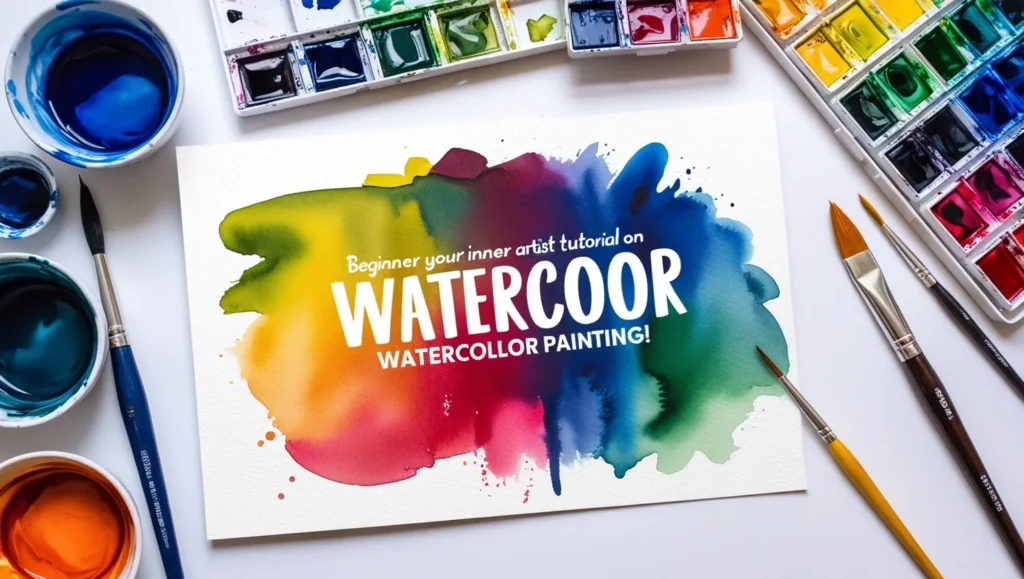Learn to Paint with Watercolors
Watercolor painting is an art form celebrated for its elegance, subtlety, and versatility. Whether you’re an aspiring artist or someone looking for a creative hobby, watercolors are an excellent medium to explore. Learn to Paint with Watercolors This tutorial will walk you through the basics of watercolor painting, ensuring you feel confident as you start your artistic journey.
Why Choose Watercolors?
Watercolors are perfect for beginners due to their simplicity and minimal equipment requirements. The soft, translucent washes create stunning effects, making it a favorite for landscapes, florals, and abstract art. Learn to Paint with Watercolors It’s also a relatively low-cost art form, making it accessible to everyone.
Essential Materials You’ll Need
To start painting with watercolors, gather these essential tools:
- Watercolor Paints: Choose between tubes or pans. A basic set with primary colors is ideal for beginners.
- Brushes: Invest in round brushes of sizes 6, 8, and 10, which are versatile and perfect for various techniques.
- Watercolor Paper: Opt for 140 lb (300 gsm) cold-pressed paper, which is textured and absorbs water well.
- Palette: A plastic or ceramic palette for mixing colors.
- Water Jars: Two jars—one for rinsing brushes and one for clean water.
- Tissue or Cloth: For blotting excess water or correcting mistakes.
Step 1: Understand Basic Techniques
Before diving into painting, practice these foundational techniques:
- Wet-on-Wet: Apply water to the paper, then add pigment. This creates soft, blended effects, ideal for skies or backgrounds.
- Wet-on-Dry: Paint directly onto dry paper for sharp, defined edges.
- Dry Brush: Use a brush with minimal water to add texture and details.
- Layering (Glazing): Apply thin layers of color on top of dried paint to build depth and richness.
- Lifting: Use a tissue or dry brush to lift pigment from the paper to create highlights.
Step 2: Experiment with Color Mixing
Learn to mix colors to expand your palette. Start with primary colors (red, blue, yellow) to create secondary shades. Learn to Paint with Watercolors Experiment with light and dark tones by adding water to dilute colors or layering pigments for intensity.
Step 3: Practice Simple Shapes
Begin by painting simple shapes such as circles, squares, and leaves. Learn to Paint with Watercolors Focus on brush control and experimenting with the flow of water and paint.
Step 4: Create Your First Painting
Once comfortable, try painting a basic scene, such as:
- Sky and Mountains: Use the wet-on-wet technique for the sky and add wet-on-dry layers for mountain details.
- Floral Designs: Paint loose, colorful flowers with round brushes.
- Abstract Art: Play with color splashes, gradients, and shapes for a unique creation.
Tips for Success
- Start Light, Build Dark: Watercolors are transparent, so work from light to dark tones.
- Embrace Imperfections: Watercolors can be unpredictable. Let the medium guide you for organic effects.
- Keep Practicing: Like any skill, practice is key. Dedicate time to experiment and refine your technique.
- Watch Tutorials: Online resources provide invaluable guidance for beginners.
Common Beginner Mistakes and How to Avoid Them
- Using Too Much Water: Over-saturated paper can buckle or lose detail. Balance water and pigment.
- Overworking the Paper: Repeated brushing can damage the paper. Work lightly and with intention.
- Skipping Practice: Focus on learning techniques before tackling complex paintings.
Why Watercolor Painting is Worth the Effort
Watercolors foster creativity and mindfulness. As you paint, you’ll find a sense of relaxation and joy in watching colors blend and flow. Over time, your skills will grow, and you’ll be able to create intricate, beautiful works of art.
Final Thoughts
Starting with watercolors might seem intimidating, but with patience and practice, you’ll soon find your artistic voice. Gather your supplies, carve out some time, and let your creativity flow onto the paper. Remember, every masterpiece begins with a single brushstroke!

